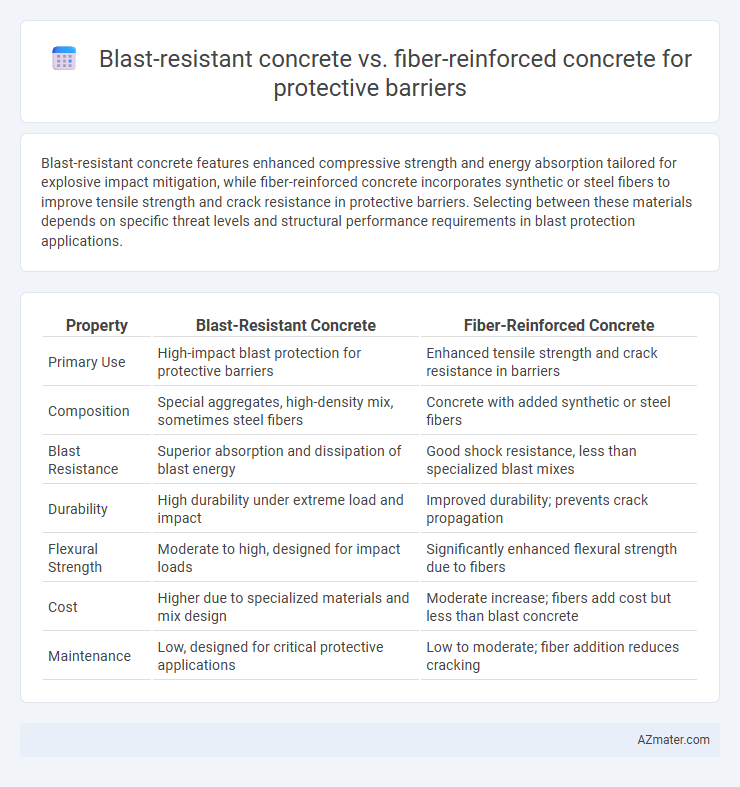Blast-resistant concrete features enhanced compressive strength and energy absorption tailored for explosive impact mitigation, while fiber-reinforced concrete incorporates synthetic or steel fibers to improve tensile strength and crack resistance in protective barriers. Selecting between these materials depends on specific threat levels and structural performance requirements in blast protection applications.
Table of Comparison
| Property | Blast-Resistant Concrete | Fiber-Reinforced Concrete |
|---|---|---|
| Primary Use | High-impact blast protection for protective barriers | Enhanced tensile strength and crack resistance in barriers |
| Composition | Special aggregates, high-density mix, sometimes steel fibers | Concrete with added synthetic or steel fibers |
| Blast Resistance | Superior absorption and dissipation of blast energy | Good shock resistance, less than specialized blast mixes |
| Durability | High durability under extreme load and impact | Improved durability; prevents crack propagation |
| Flexural Strength | Moderate to high, designed for impact loads | Significantly enhanced flexural strength due to fibers |
| Cost | Higher due to specialized materials and mix design | Moderate increase; fibers add cost but less than blast concrete |
| Maintenance | Low, designed for critical protective applications | Low to moderate; fiber addition reduces cracking |
Introduction to Protective Barriers: Importance and Applications
Protective barriers designed with blast-resistant concrete offer superior impact absorption and fragmentation resistance critical for safeguarding infrastructure in high-risk zones such as military bases and industrial facilities. Fiber-reinforced concrete enhances tensile strength and crack resistance, making it effective in protective barriers that require flexibility and durability under dynamic loading conditions like vehicle impacts and seismic events. Selecting between blast-resistant and fiber-reinforced concrete depends on the specific threat profile and structural performance requirements of security and safety applications.
Overview of Blast-Resistant Concrete
Blast-resistant concrete is engineered to withstand high-intensity explosions by incorporating dense aggregates, high-strength cement matrices, and energy-absorbing additives that enhance structural durability and reduce spallation. This specialized concrete typically includes steel fibers, polypropylene fibers, or composite reinforcements to improve tensile strength and crack resistance under blast loading. It is widely used in protective barriers for military installations, critical infrastructure, and urban security applications where resilience against shock waves and flying debris is crucial.
Understanding Fiber-Reinforced Concrete Technology
Fiber-reinforced concrete (FRC) enhances protective barriers by integrating synthetic or steel fibers within the cement matrix, significantly improving tensile strength, impact resistance, and energy absorption capacity compared to traditional blast-resistant concrete. The fibers bridge cracks, limit crack propagation, and increase ductility, allowing FRC to better withstand explosive loads and dynamic pressure from blasts. Advanced FRC technology offers tailored fiber types and dosages to optimize barrier performance against specific blast threats while maintaining structural integrity and durability.
Key Material Properties: Strength, Ductility, and Durability
Blast-resistant concrete exhibits exceptionally high compressive strength and superior energy absorption capacity, making it ideal for protective barriers subjected to explosive impacts. Fiber-reinforced concrete enhances ductility significantly through internal fiber networks that control crack propagation and improve post-cracking behavior under dynamic loads. Both materials demonstrate enhanced durability, with blast-resistant concrete offering resistance to extreme pressure and fiber-reinforced concrete providing resilience against abrasion and environmental stresses, ensuring long-lasting protective performance.
Performance Under Blast Loads: Comparative Analysis
Blast-resistant concrete exhibits superior performance under high-intensity blast loads due to its dense matrix and engineered reinforcement, effectively absorbing and dissipating shock waves. Fiber-reinforced concrete enhances energy absorption and controls crack propagation through distributed fiber networks, providing improved post-blast structural integrity. Comparative analyses highlight that while blast-resistant concrete excels in immediate blast mitigation, fiber-reinforced concrete offers better residual strength and durability after exposure to explosive forces.
Construction Methods and Practical Considerations
Blast-resistant concrete involves dense, high-strength mixtures with additives like silica fume and special aggregates to absorb and dissipate explosive energy, often requiring careful formwork and curing processes to maintain integrity under shock loads. Fiber-reinforced concrete incorporates synthetic or steel fibers, enhancing tensile strength and crack control with simpler mixing but demands uniform fiber dispersion and specialized placing techniques to avoid fiber clumping. Practical construction considerations include blast-resistant concrete's higher material costs and extended curing times versus the relatively quicker installation and improved durability against impact and spalling offered by fiber-reinforced options.
Cost Efficiency and Lifecycle Analysis
Blast-resistant concrete offers superior strength and durability, leading to enhanced protection but comes with higher initial costs due to specialized materials and complex casting processes. Fiber-reinforced concrete provides improved crack resistance and flexibility at a lower material cost, resulting in cost-efficient maintenance and repair over the lifecycle. Lifecycle analysis indicates that fiber-reinforced concrete typically delivers better cost efficiency through reduced downtime and extended service life, despite slightly lower blast resistance compared to high-performance blast-resistant mixtures.
Maintenance Requirements and Longevity
Blast-resistant concrete offers superior durability and requires minimal maintenance due to its dense composition and ability to absorb and dissipate explosive energy, making it highly suitable for long-term protective barriers. Fiber-reinforced concrete enhances tensile strength and crack resistance, which reduces repair frequency but may necessitate periodic inspections to address fiber degradation and matrix wear. Selecting concrete types depends on specific threat levels and environmental exposure, with blast-resistant variants generally providing longer service life and lower overall maintenance costs.
Sustainability and Environmental Impact
Blast-resistant concrete utilizes dense aggregates and chemical admixtures to absorb and dissipate explosive forces, often requiring high cement content that increases carbon emissions. Fiber-reinforced concrete, incorporating steel, glass, or synthetic fibers, enhances durability and crack resistance with lower cement usage, resulting in reduced environmental footprints and longer service life. Choosing fiber-reinforced concrete for protective barriers promotes sustainability by minimizing resource consumption and enabling easier repair, thereby lowering overall lifecycle environmental impact.
Choosing the Right Concrete Solution for Protective Barriers
Blast-resistant concrete offers superior compressive strength and energy absorption, making it ideal for protective barriers against high-impact explosions. Fiber-reinforced concrete enhances tensile strength and crack resistance, improving durability under dynamic loads and reducing maintenance costs. Selecting the right concrete solution depends on the expected threat level, structural design requirements, and long-term performance needs for safeguarding infrastructure and personnel.

Infographic: Blast-resistant concrete vs Fiber-reinforced concrete for Protective barrier
 azmater.com
azmater.com